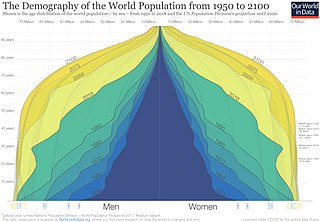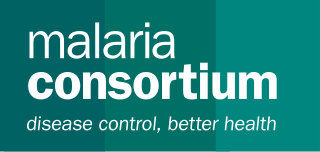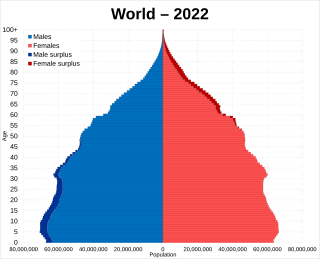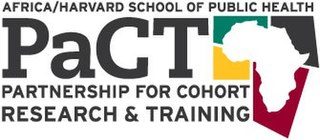Services
The Population Reference Bureau offers an annual World Population Data Sheet, which is a chart containing data from 200 countries concerning important demographic and health variables, such as total population, fertility rates, infant mortality rates, HIV/AIDS prevalence, and contraceptive use. [7]
The PRB's online data allows users to search a database of hundreds of demographic, health, economic, and environmental variables for countries and regions all around the world, such as the Middle East, Latin America, and Sub-Saharan Africa. The database provides scholarly articles about an assortment of topics, ranging from noncommunicable diseases and nutrition to the labor force and family planning. [5]
The PRB also publishes a Population Bulletins, information about demographic concepts to help in educating the public on population studies. [8]
Among these, other data and population tools available to the public from the PRB include population bulletins and customizable training and educational materials, presented through visual, written and online publications. [9]
Programs and projects
The method used by the Population Reference Bureau involves focusing on educating people within the project areas, and then utilizing them to make changes within populations. [3]
The Population Reference Bureau has both past and current programs and service projects around the globe, mainly focused in the United States, and parts of the developing world including Sub-Saharan Africa and the Middle East. Projects in the United States vary from analyses of demographic and economic data, projects aiding collecting data for the American Community Survey, and studying factors of aging and factors of health in children. International projects focus on learning about health and disease for at risk populations, family planning and reproductive health, and further using this learned knowledge to establish programs to improve communities. [10] Current projects of the Population Reference Bureau include; Demographic and Socioeconomic Trends in the Appalachian region of the United States, Combatting Noncommunicable Disease Risk Factors in Youth across Latin America and the Caribbean, North Africa and the Middle East, Asia, and Africa, and their current featured project; Evidence to End Female Genital Mutilation/Cutting across the globe. [10]

Demography is the statistical study of human populations: their size, composition, and how they change through the interplay of fertility (births), mortality (deaths), and migration.
Human body weight is a person's mass or weight.
The 10/90 gap is the term adopted by the Global Forum for Health Research to highlight the finding by the Commission on Health Research for Development in 1990, that less than 10% of worldwide resources devoted to health research were put towards health in Developing Countries, where over 90% of all preventable deaths worldwide occurred. Every year, the spread of disease suffered in both rich and poor countries converges. According to the World Health Organization (WHO), the most prevalent diseases consist of cardiovascular disease, cancer and diabetes. These diseases now account for 45% of the global health burden and are the culprit for up to 85% of deaths in low-income countries. The 10/90 Gap focuses on joining organizations together to reduce these statistics.

Global health is the health of the populations in the worldwide context; it has been defined as "the area of study, research, and practice that places a priority on improving health and achieving equity in health for all people worldwide". Problems that transcend national borders or have a global political and economic impact are often emphasized. Thus, global health is about worldwide health improvement, reduction of disparities, and protection against global threats that disregard national borders, including the most common causes of human death and years of life lost from a global perspective.

The global epidemic of HIV/AIDS began in 1981, and is an ongoing worldwide public health issue. According to the World Health Organization (WHO), by 2023, HIV/AIDS had killed approximately 40.4 million people, and approximately 39 million people were infected with HIV globally. Of these, 29.8 million people (75%) are receiving antiretroviral treatment. There were about 630,000 deaths from HIV/AIDS in 2022. The 2015 Global Burden of Disease Study estimated that the global incidence of HIV infection peaked in 1997 at 3.3 million per year. Global incidence fell rapidly from 1997 to 2005, to about 2.6 million per year. Incidence of HIV has continued to fall, decreasing by 23% from 2010 to 2020, with progress dominated by decreases in Eastern Africa and Southern Africa. As of 2020, there are approximately 1.5 million new infections of HIV per year globally.

The Population Council is an international, nonprofit, non-governmental organization. The Council conducts research in biomedicine, social science, and public health and helps build research capacities in developing countries. One-third of its research relates to HIV and AIDS; while its other major program areas are in reproductive health and its relation to poverty, youth, and gender. For example, the Population Council strives to teach boys that they can be involved in contraceptive methods regardless of stereotypes that limit male responsibility in child bearing. The organization held the license for Norplant contraceptive implant, and now holds the license for Mirena intrauterine system. The Population Council also publishes the journal Population and Development Review, which reports scientific research on the interrelationships between population and socioeconomic development. It also provides a forum for discussion on related issues of public policy and Studies in Family Planning, which focuses on public health, social science, and biomedical research involving sexual and reproductive health, fertility, and family planning.

The population of Africa has grown rapidly over the past century and consequently shows a large youth bulge, further reinforced by a low life expectancy of below 50 years in some African countries. Total population as of 2020 is estimated to be more than 1.3 billion, with a growth rate of more than 2.5% p.a. The total fertility rate for Africa is 4.7 as of 2018, the highest in the world according to the World Bank. The most populous African country is Nigeria with over 206 million inhabitants as of 2020 and a growth rate of 2.6% p.a.

Tropical diseases, especially malaria and tuberculosis, have long been a public health problem in Kenya. In recent years, infection with the human immunodeficiency virus (HIV), which causes acquired immune deficiency syndrome (AIDS), also has become a severe problem. Estimates of the incidence of infection differ widely.
Population Action International (PAI) is an international, civil society organization that uses research and advocacy to improve global access to family planning and reproductive health care. Its mission is to "advance universal access to sexual and reproductive health and rights through advocacy, partnerships and the funding of changemakers". PAI's headquarters is in Washington, D.C.

In world demographics, the world population is the total number of humans currently living. It was estimated by the United Nations to have exceeded eight billion in mid-November 2022. It took around 300,000 years of human prehistory and history for the human population to reach one billion and only 222 years more to reach 8 billion.

HIV/AIDS in Lesotho constitutes a very serious threat to Basotho and to Lesotho's economic development. Since its initial detection in 1986, HIV/AIDS has spread at alarming rates in Lesotho. In 2000, King Letsie III declared HIV/AIDS a natural disaster. According to the Joint United Nations Programme on HIV/AIDS (UNAIDS) in 2016, Lesotho's adult prevalence rate of 25% is the second highest in the world, following Eswatini.

Malaria Consortium is an international non-profit organization based in Cambridge Heath, London, specializing in the comprehensive control of malaria and other communicable diseases – particularly those affecting children under five.

Sameh El-Saharty is an Egyptian medical doctor and global health expert, who works as Lead Health Policy Advisor at The World Bank in Washington, DC. Dr. El-Saharty joined the Bank in 1998 and was the first Egyptian to work in the health, population, and nutrition (HNP) sector at the World Bank since its establishment. During this period, he was responsible for leading the health policy dialog and health strategy development for client countries as well as managing several programs and projects amounting to more than $3.5 billion in more than 25 countries in three world regions. Before his current position, he was the Program Leader for Human Development, responsible for the HNP, education, social protection and labor markets in the Gulf Cooperation Council countries. He also held the position of Adjunct Assistant Professor of International Health at Georgetown University in Washington, D.C.

Earth has a human population of over 8 billion as of 2024, with an overall population density of 50 people per km2. Nearly 60% of the world's population lives in Asia, with almost 2.8 billion in the countries of China and India combined. The percentage shares of China, India and rest of South Asia of the world population have remained at similar levels for the last few thousand years of recorded history. The world's literacy rate has increased dramatically in the last 40 years, from 66.7% in 1979 to 86.3% today. Lower literacy levels are mostly attributable to poverty. Lower literacy rates are found mostly in South Asia and Sub-Saharan Africa.

The Africa/Harvard School of Public Health Partnership for Cohort Research and Training launched in 2008, is a collaborative research project led by Principal Investigators, Dr. Hans-Olov Adami and Dr. Michelle D. Holmes. Together with research scientists, Dr. Shona Dalal and Dr. Todd G. Reid, this team represents the Harvard Coordinating Site of the Partnership with colleagues from five institutions in Nigeria, South Africa, Tanzania, and Uganda. The Africa/HSPH PaCT project plans on investigating the association of lifestyle factors and chronic disease risk in sub- Saharan Africa, through a large epidemiological cohort study that will include approximately 500,000 participants. Africa/HSPH PaCT is the first and largest cohort study conducted in sub-saharan Africa to employ mobile phone technology to follow participants and collect data. Africa/HSPH PaCT will also provide the infrastructure for capacity-building and for training a new generation of health professionals.
Below are two tables which report the average adult human height by country or geographical region. With regard to the first table, original studies and sources should be consulted for details on methodology and the exact populations measured, surveyed, or considered. With regard to the second table, these estimated figures for said countries and territories in 2019 and the declared sources may conflict with the findings of the first table.

Access to safe and adequate sexual and reproductive healthcare constitutes part of the Universal Declaration of Human Rights, as upheld by the United Nations.
Seychelles has reached the epidemiological shift from communicable to noncommunicable diseases. Most communicable and infectious diseases have been controlled or eradicated. In 2014 the World Health Organization reported that the country was on target to achieve the Millennium Development Goals and had addressed some of the social determinants of health.













